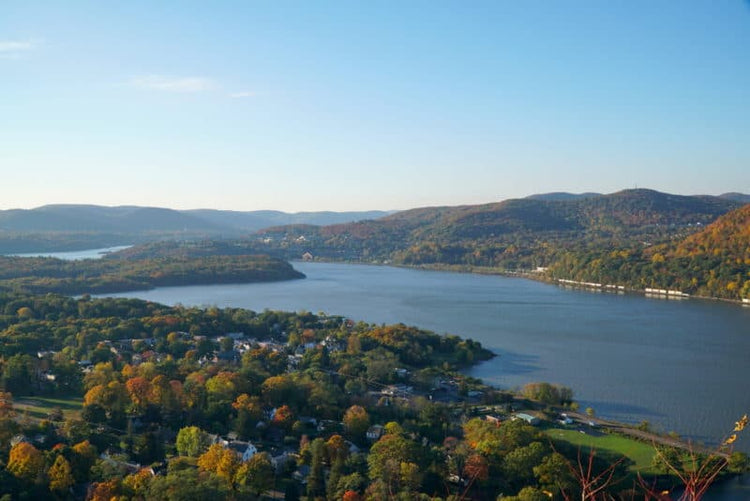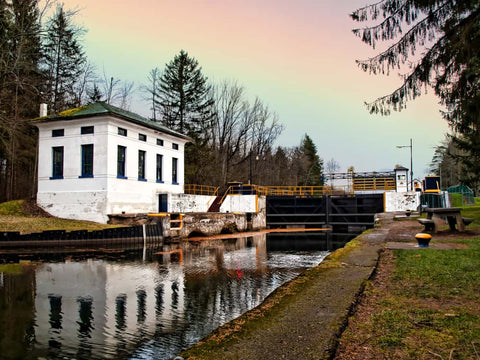The Complete Canal Boat Getaway to Experience New York State

You've not seen New York until you've seen it from a canal boat getaway. Fishing, paddling, dining, wine tours, history and so much more ... the New York State Canals System offers a truly unique and memorable way to experience the Empire State.
Take a trip along an NY canal, and you'll return time and again to explore all there is to offer. Let me entice you to pack up and toss a dock line along a NY canal.
Our Recommended Product
Miles and Miles to Enjoy!
The New York State Canal System is a marvel of 19th-century engineering and a designated National Historic Landmark. In centuries past, these canals served a vital economic role as a commercial lifeline for tens of thousands of Americans.
The state boasts more than 525 miles of connected canals that begin near Buffalo, NY and connect Lake Erie in the west to cities such as Rochester, Syracuse, Utica and Albany to the Hudson River all the way down to New York City.
Prized for scenery, recreation and easy water access to everything from quaint river towns to major metropolitan cities, the canals offer more than just a commercial throughway these days.
Our Recommended Product
The Eight-Year Construction of the New York Canal System

Carving out the Erie Canal in 1817 commenced construction of what would become New York's canal system. It took eight years to complete the 363-mile-long project. But in the end, the new waterway opened up access to the interior of the young American nation practically overnight.
The Erie Canal connected the Great Lakes with the Atlantic Ocean, making the transport of goods and passengers easier and more efficient. Not only did more settlers, traders and pioneers begin packing up and heading west along the canal, but the volume of commerce flowing through New York City skyrocketed.
Over time, three more canals were added - the Oswego Canal, the Cayuga-Seneca Canal and the Champlain Canal - and the combined waterways became the commercial heart of northeastern America for decades.
Only when railroads crisscrossed the nation were canals eclipsed in economic importance. Today, much commercial traffic still travels along the New York State Canal System, but they're primarily appreciated for their history and recreational opportunities. There are lots of historical sites and recreational activities to enjoy as well.
Our Recommended Product
Getting Around on a New York Canal

The New York State Canal System features dozens of locks operated by the U.S. Army Corp of Engineers. Each lock allows the connection of waterways located at varying altitudes. This also allows boaters a throughway and access.
The trick, however, is to plan accordingly. Most locks operate from 7 AM to 5 PM, although selected locks and lift bridges operate later.
Check the specific locks and bridges that lie ahead in your journey to make sure you're never stuck for the night.
Where Can You Go Via NY Canal?
The 525-mile system connects Buffalo in the east to the Vermont border in the west. Thanks to the access created by the Great Lakes via the Hudson River and the Atlantic Ocean, there's no shortage of water to navigate.
Notable towns and cities along the way include Syracuse, Utica, Rochester, Schenectady, Albany and Troy, to name but a few. And, of course, NYC via the Hudson River.
Our Recommended Product
Stopping Along the Way
You won't complete the 500-plus mile canal trip in a single day. So, it's wise to identify a few marinas along the course of your journey to plan a good time to stop for the day.
The Erie Canal has dozens of marinas with few spaced more than 10 miles apart. The other legs of the system are equally well-equipped to harbor boats overnight and for shorter stops during the day if you need to tie up for a while.
Just note: Only about half of the marinas along the New York State Canal System offer fuel, but almost all of them have electrical and water hookups.
What Kinds of Boats Use the NY State Canal System?

On a trip along New York's canals, you'll see many different watercraft plying the storied system. Paddlers in kayaks and canoes are common in warm summer months. Pontoon boats and deck boats are ubiquitous as their steady pace and easy-to-control qualities are ideally suited for narrow channels.
But larger pleasure craft - such as 50-foot cruisers or 60-foot houseboats - are also often spotted at anchor, sail and motor, as are smaller sailing vessels and fishing boats.
Gone, however, are the horse-drawn boats of yesteryear, although a few spots in America still offer rides in replica boats. Note that "horse-drawn" is a misnomer. Mules did the work in almost all cases. Gotta give credit where credit's due.
Our Recommended Product
New York Canal Boat Rentals
So you don't own a boat (or don't want to use it), but still want to enjoy the canals of New York State? No problem! Dozens of boat rental outlets are available along the canals and offer everything from kayaks and canoes to row boats and fishing boats.
You can get a bit more adventurous and rent a jet ski or a hydro bike. And if you're bringing the whole family along, consider renting a larger pontoon boat, cruiser or even an English-style narrowboat.
Cruising on the New York State Canal System
If you want to enjoy a historic, scenic New York canal trip but don't want to paddle, row, sail or steer your own vessel, you can book a cruise!
Some canal boat cruises are half-day outings with meals, music, drinks and dancing. Others can be relaxing and memorable multi-day vacations.
You can book a history-themed cruise, take a sightseeing outing or join a fishing expedition. Many companies offer private charter boats. Don't forget about winery canal tours complete with plenty of wine-tasting opportunities.
Featured Boat Care Product
Check Price on Amazon - Better Boat's boat soap quickly breaks down dirt, dust and grime. Simply use a hose and nozzle to rinse away. Use a microfiber cloth for set-in stains. It's eco-friendly, biodegradable and won't harm the marine environment.
How to Make the Most of Your New York Canal Boat Trip
Much of a New York canal trip's fun comes from being on the water. You can paddle SUPs and kayaks, go fishing and simply watch the scenery slide by. The slow pace and lovely landscapes along the canals can help anyone unwind.
But there are also countless activities along the canal's banks. Bikers love using the old mule trails that run along the canals, as do hikers. Many campsites along the Canalway Trail offer a dry night off the water.
Along the many miles of canals, you'll find wineries, museums, shopping, dining and plenty more opportunities to explore the long history of the region, much of which predates the canals and America itself. Throw out a dock line and enjoy the sites!
During peak summer months, there are regular performances, events and festivals that take place near the water. From live music to food-themed celebrations to wine and beer-centric events, there's always something exciting along the water.
Our Recommended Product
Better Boat Microfiber Sponge Set
New York Canals: Past, Present, and Future
In the days of massive ocean-going container ships, heavy rail transport and four-engine cargo jets, canals have lost much of their relevance as commercial engines.
But in our ever faster-paced and frenzied global world, the inherently slow pace of canal travel is ever more attractive to those people looking for recreation and relaxation.
In the past, the New York State Canal System was expanded multiple times, with miles of waterway added and extant stretches widened. Today, the key is preservation. 200 years after work on the NY canals began, the canals are there for all to enjoy. With a bit of luck, they'll endure for many generations into the future.









